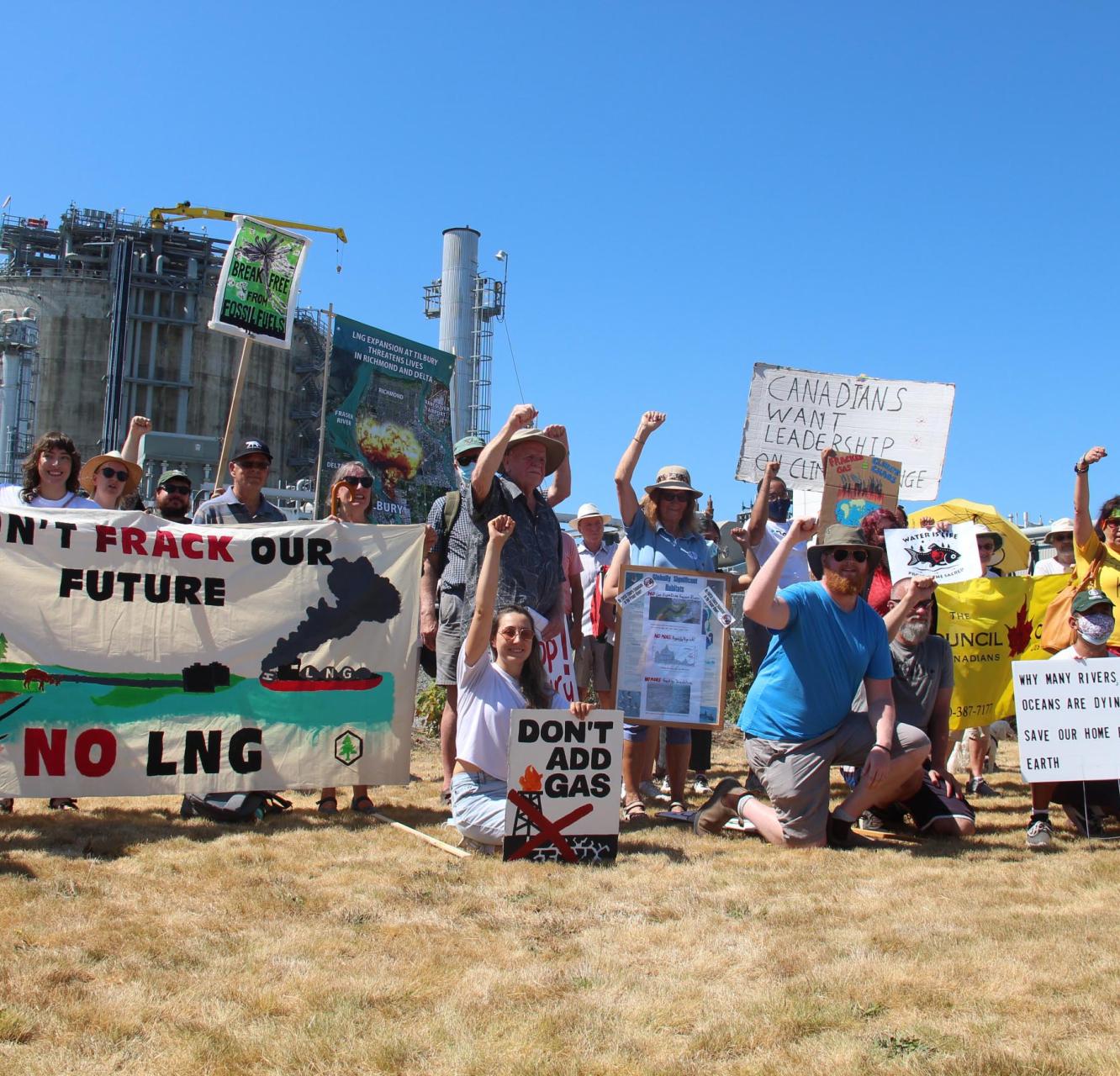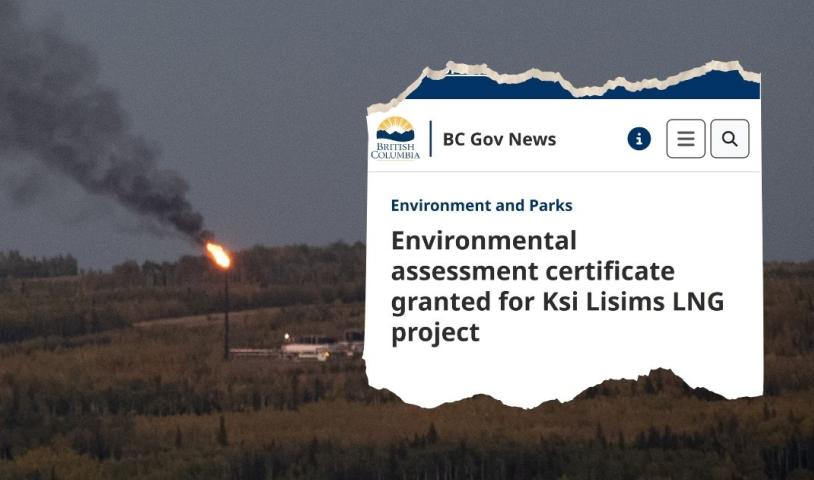Notes From B.C.’s ‘Sacrifice Zone’
Thursday, October 10, 2024
My name is Jason Hjalmarson and for the last two years I’ve worked as an outreach organizer for the Wilderness Committee on the campaign to end fracking in B.C. Earlier this year, I visited Northeast B.C. — a region described as a “sacrifice zone” as much of the fracking in the province is concentrated there.
I joined colleagues from Frack Free BC, an alliance made up of the Wilderness Committee, Dogwood and STAND.earth. Our organizations collaborate on action planning and activist engagement to make our efforts to end fracking as effective as possible.
If you’re not familiar, fracking is a destructive practice used to extract so-called “natural gas” (which is really mostly methane). It uses a huge amount of freshwater and releases a lot of polluting greenhouse gases into our atmosphere, harming our ability to meet our climate targets.
Visiting the places most impacted by fracking and seeing its effects firsthand was eye opening, and helped remind us all why we are doing what we do. There are more than ten thousand active fracking well sites in B.C., and thousands more that are inactive. Each fracking well is only productive for a few years. Eventually, every well will stop producing gas. This means the new Liquified Natural Gas (LNG) facilities the provincial government is approving require constant approval of more new fracking sites, and the constant impact this drilling causes. To keep production going, hundreds of new fracking wells are drilled while hundreds more are decommissioned every year.
Northeast B.C. is incredibly beautiful, but the natural scenery is marred with evidence of the fracked gas industry everywhere you look.
B.C.’s provincial government made the decision to get big into fracking back around 2013, when then premier Christy Clark claimed it would make our province debt free. Today, despite the fact that most of the world is moving away from oil and gas because of its harm to the climate, B.C. stubbornly continues to build new gas infrastructure, drill new fracking wells and approve new export and storage facilities.
It’s easy to forget how big the province is. Geographically, British Columbia is larger than every state in America except Alaska. For this reason, despite the huge increase in fracking, public awareness has remained low as fracking mostly happens in the northeastern corner of the province.
From Vancouver, it can feel like the industry is hiding up north, but for the more than 72,000 people who live in Northeast B.C., there is nothing hidden about the fracking industry or its impact on the surrounding landscape and daily life.
One landowner we visited, who asked us to keep their name private, had already moved away from a property because it was located close to a drilling site for a new fracking well. As we sat around their kitchen table, they told us about how living near the site was like being “beside a jet engine that’s going 24/7.” Now living on a different property, they’re worried about going through the same thing all over again. We quickly learned how small landowners have little recourse in trying to stop a gas company from drilling a fracking well next door.

We spent much of our time driving along country roads to document and photograph fracking operations. We saw large hoses and tubes running along the side of the road for huge distances, and learned these were for pumping freshwater to fracking drill sites.
In 2023, oil and gas companies withdrew over six billion litres of fresh water from lakes and rivers in B.C., a new record and a 16 per cent increase from last year. After it's been used in the fracking process, the water is badly contaminated with toxic chemicals and must be treated. It sits in large “decontamination tanks” that have brightly coloured ribbons hanging all over them to prevent birds from landing in the toxic water. When we visited one of these waste-water tanks, the smell from the water was so foul you could taste it in the air from the road and it gave me a headache.

Northeast B.C. is incredibly beautiful, but the natural scenery is marred with evidence of the fracked gas industry everywhere you look. Oil and gas is inescapable here; facilities are located near parks or beside elementary schools, or on farmers’ fields where cattle are grazing.
Flare stacks — huge flames burning off excess gas at the top of a tall metal tube — dot the scenery, spewing thick black smoke filled with toxic hydrocarbons. Once a well is drilled and construction is finished, the “frack pad” appears fairly innocuous. Looking at one, you’d have no idea what it is, but several studies have confirmed these innocent appearing well sites leak methane gas into the atmosphere at rates higher than what governments and corporations admit.
As we spent time in the area, we got a sense of what we’re up against if we’re to succeed in moving away from this destructive industry. We saw the way fracking has scarred the landscape and harmed the environment, and witnessed the challenges of mitigating this damage.
For example, we visited a nursery greenhouse that grows native plants to be used in well site reclamation, and then met with staff from one of the remediation companies that uses the plants grown there. These workers estimated the restoration cost for just one former fracking well site, with moderate levels of contamination, could range anywhere from $750,000.00 to $3 million. When you multiply that cost with the thousands of wells that will eventually need remediation, the full picture of how we are burdening future generations gets clearer.
We met with dedicated community activists who were featured in the documentary film Fracking the Peace, like Dr. Ulrike Meyer, a physician who has raised awareness about the negative impacts of fracking on human health, and Don Petite of the Peace Energy Cooperative, who is bringing renewable energy to the region. If you’ve not had the opportunity to see the film yet, feel free to reach out to arrange a screening. If you don’t have the opportunity to visit the area firsthand, hearing from Dr. Ulrike, Don and other locals is the next best thing.
Northeast B.C. is home to vibrant, resilient communities and a lot of incredible natural beauty and wildlife. Spending time there though, the “sacrifice zone” moniker became painfully clear to me. It helped remind us all why we are doing what we do.
We know a better way is possible without anyone or anyplace being sacrificed. We're working every day to raise awareness about what’s happening to the people and land in Northeast B.C. The provincial government must set a date for the end of fracking in B.C., begin to draw down oil and gas activities, and make serious investments in a sustainable long-term future.
You can join the fight to end fracking in B.C. by signing the Wilderness Committee’s petition to end fracking and by visiting FrackFreeBC.ca to get involved in our upcoming actions.
Thanks for reading and feel free to get in touch with me if you have questions about our campaign or how to get involved: jason@wildernesscommittee.org.




